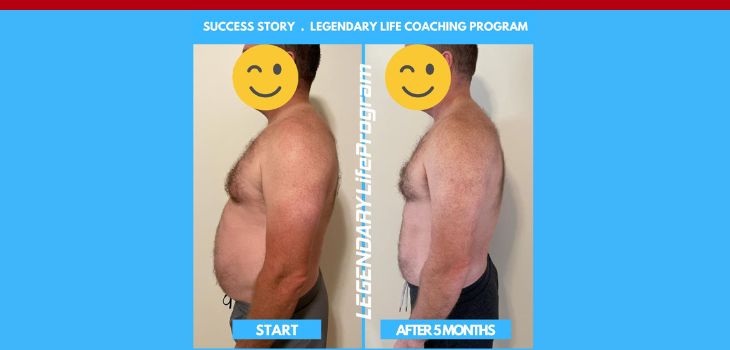Unless you’ve been living under a rock, you’ve probably heard that VO2 max is one of the strongest indicators of longevity and peak health. And you’ve probably also heard about Zone 2 training and HIIT protocols like the 4×4 method as the go-to strategies for improving it.
But what if there’s a more effective and easier way to boost your VO2 max that no one is talking about? Not Peter Attia, not Andrew Huberman—nobody.
In this episode, Ted breaks down Decreasing High-Intensity Intervals (DHI)—a little-known yet powerful approach to VO2 max training that could yield better results than traditional methods. He explains why most people struggle with the brutal 4×4 protocol, how DHI keeps you at higher VO2 levels for longer, and why it could be a game-changer for busy high performers.
If you’re looking to improve your fitness, boost longevity, and avoid exhausting, unsustainable workouts, this episode will introduce you to a smarter way to train. Listen now!
You’ll learn:
- Why VO2 max is one of the most important predictors of longevity
- Why traditional HIIT methods like the 4×4 protocol might not be the best approach
- The Decreasing High-Intensity Interval (DHI) method and how it works
- Why spending more time at high VO2 levels matters more than just doing intervals
- How to implement DHI training into your weekly routine
- The best cardio equipment for maximizing VO2 max improvements
- How this method leads to better energy levels, endurance, and fat loss
- And much more…
Related Episodes:
Links Mentioned:
Learn More About The Unstoppable After 40 Coaching Program
Join The Unstoppable After 40 Newsletter
Schedule a Strategy Call with Ted
Connect with Ted on X and Instagram
Ready to make 2025 your best year ever?
Together, we’ll craft a personalized plan to reclaim your health and transform your body in a way that fits your busy lifestyle.
If you want to learn more about our Unstoppable After 40 Coaching Program, click here!
We have limited spots, so click here to book a call now!
Podcast Transcription: How to Boost Your VO2 Max with a Training Method You’ve Never Heard Of
Ted Ryce: So unless you've been living underneath a rock, you know, that VO two max is tied to living a long, healthy life. And you probably also know that zone two training and hit training protocols, like the four by four protocol, for example, are the most popular talked about methods for improving VO two max.
But today I'm going to share with you something that nobody's talking about. Not Peter Atiyah, not Andrew Huberman, not anyone. Not anyone that you're listening to. So if you want to learn a secret method of boosting your VO two max and something that is much, let's say, easier to do, easier to implement than the Norwegian four by four protocol, you're in the right place.
What is up my friend and welcome back to the show. My name is Ted Rice. I'm a health expert and coach for over 25 years now. And today we're going to be talking about decreasing high intensity intervals. Have you ever heard of that? Well, nobody else is talking about it. Again, nobody that you're following.
Maybe if you're a hardcore endurance athlete, you already know about this, but if you're following the influencers and you, Hey, I'm, I'm an influencer too. I really like Peter Atiyah, Andrew Huberman, uh, less than Peter Atiyah, but. Yeah, I appreciate them too, but they talk about what's popular and there's nothing wrong with that.
I talked about the, the four by four protocol as well, but I deal with actual people like my client who basically told me if I have to do this four by four protocol to live a long, healthy life, I think I'm okay dying early. And just to remind you, if you don't know what the four by four protocol is, four minutes of high intensity interval with three minutes rest afterward, repeated four times.
And it is brutal. Okay. It's brutal. It really sucks. So if you're doing like some YouTube hit workout, but, and it's like, yeah, well, first I do these burpees and then I do some body weight squat. You're not doing hit training. Okay. You're doing circuit training. There's nothing wrong with it, but it's not hit training.
You need a piece of a cardio, you need a piece of cardio equipment to really push yourself. And if you've ever tried the 4x4 protocol, because it's so popular, you know just how hard it is. Now look, Zone 2 and the 4x4 protocol are effective, but there's this lesser known method that could actually be better VO2max and overall endurance.
Again, it's called decreasing high intensity intervals or DHI. And if you're looking to perform your best and improve your cardiovascular health, this might be the thing that you're missing, especially if you hate doing, uh, the high intensity interval training routine. So what is decreasing high intensity interval training or DHI?
Well, it's a method where you perform high intensity exercise intervals. But the duration of the work and rest periods decrease as you go. I'll, I'll explain what that means, but just to contrast it really quick. When you do the 4x4, the Norwegian 4x4 protocol, you do 4 minutes with 3 minutes of rest. 4 minute interval with 3 minutes of rest.
Repeat it 4 times. So, but here's what we're starting to learn. The goal of high intensity interval training is to keep your heart rate elevated at high levels for longer. This is the thing that improves your VO2max and overall fitness. So, in simpler terms, With DHI, you start with longer, tougher intervals and finish with shorter, more intense bursts.
And this forces your body to keep working harder and harder, getting the most out of every workout. And really what, what ends up happening here, uh, and I'll talk about this in a second, is you just spend more time at higher VO2 levels. Okay. So I'll talk about that in a second, but why should you care about this?
Well, high performing individuals. I mean, VO two max isn't just a number. It's the key to feeling your best. Do you want to still have a high sex drive in your fifties or sixties? You better have a high VO two max. Do you want to prevent preventable diseases? You better have a high VO two max. Do you want to be one of those people who's enjoying life?
In their seventies and maybe even eighties and quite independent, then you better have a high VO two max. So the faster your body can recover and use oxygen, the more stamina and focus you'll have throughout your work day and workouts. And the VO two max or building your VO two max is the key for that.
And again, I want you to think about this. If the idea behind. Interval trainer hit training is to keep your heart rate high. It, what matters is how much time it's not how many intervals you do, right? It's how much time do you spend keeping your heart rate past a certain level? And what they found from research, and I'll talk about this in a second, Is that DHI or decreasing high intensity intervals helps you spend more time at higher VO two levels.
And that's exactly what you need to improve your VO two max. So while we can't say DHI is better than zone two or four by four training or the Norwegian four by four protocol, this is. A good place to start. Here's why soon to training is excellent for building a foundation, but it doesn't push your body to its full potential.
And you need to do that. You don't need to do it a lot, but you need to do that for the best results for your VO two max. There's some nuance here because more recent research has shown that zone two probably is better, longer term for building VO two max than any type of hit protocol, including DHI. But the thing is the amount of time that you need to spend to put into VO two, uh, I'm sorry, zone two training.
Not going to be doable for a lot of people, unless you're already some type of endurance athlete or able to commit to an endurance athlete schedule of training. Does that make sense? So anyway, the four by four protocol, again, that's four minutes of hard work with three minutes rest is good, but DHI allows you to spend even more time at your maximum oxygen levels.
And this has been shown to lead to greater VO2 max improvements in research. Now, this is kind of new, so. It's being fleshed out and compared to other protocols. And there's a lot of debate within the protocols, but I want you to give this a try because it's so much easier to implement, for example, let me give you a simple, easy to follow DHI protocol that you can add to your training this week to see better results in less time.
So choose first, choose your cardio equipment. By the way, I like the assault bike. I like the rower. I like running. I like. Exercise. I like spinning bikes. I don't like exercise bikes that much. I used one today because there was a spinning class going on, but I'm not a huge fan of the exercise bike, but all, all of them work, but if you can, if your gym has a, a rower or a, what do you call it in assault bike in particular, the assault bike would be my, my favorite choice for doing intervals.
So after you choose what, what modality or what piece of cardio equipment you're going to use, and yeah, of course you can do running. If you want, you start with a light warmup. So say five to 10 minutes, because this is crucial. You want to get your body ready for high intensity intervals. Cause one of the issues with doing high intensity intervals is more force goes through your muscles.
But also your joints. So make sure you warm up appropriately, whatever you need to do to warm up, like whatever you do before warming up for a weight workout would be the same type of approach that I would take to warm up for a high intensity interval. And so after you warm up, now you're going to start with the longer interval.
And this is going to be three minutes of high intensity exercise at around 85 to 90 percent of your max effort. Okay? 85 to 90 percent of your max effort. And after that, you're going to follow the three minutes of high intensity exercise with two minutes of recovery at an easy pace. The next interval that you're going to do is going to be two minutes of hard effort.
Then you're going to follow it with a one minute and 40 second recovery period. And now you're going to decrease again. Now it's going to be, the next one's going to be one minute of work followed by 40 seconds of recovery. And then what you're going to do is you're going to finish with short intervals.
These are going to be 30 seconds of maximum effort, followed by 20 seconds of recovery. And you're just going to repeat this. I'll give you an example in a second. So this makes sense, but you're just going to repeat this until you can no longer maintain high intensity during your intervals. Okay. I'll talk to you about what that means in a second, because this is crucial.
This is why. People think they're doing hit training, but they're not actually doing hit training. So pay attention here. So let's start. So what that means just really quick is your effort starts to drop significantly, meaning it's you're pushing yourself for 30 seconds, but you just can't keep up the same power or speed.
So let me give you an example to make this hit home. Let's say you're cycling. Let's say you've done the whole decreasing high intensity interval routine. I just gave you, and you're at the 30 second intervals. So you're cycling at full effort for 30 seconds, then recovering for 20 seconds. If you start to feel like you're unable to hit the same power or speed during the next 30 second interval, your performance and your performance is noticeably dropping, that's time to stop.
Okay. That's time to stop. And what you can do is you can look at. It let's say if you're doing, I just said, don't use an exercise bike or that I wasn't a fan, but let's say you're using an exercise bike and you notice that you were keeping a certain power output during the first 32nd round, but then it's starting to drop off a lot.
And yes, you're, you're breathing hard and you're pushing and you're mentally tough, but you're just not able to do it. You're just not in shape enough yet. Stop. Okay. That's your signal to stop because it's not about just going in there in hard effort. It's did you get better? The next workout, okay, is this workout, the way you're doing it today, going to help you to be better for the next workout that you do.
That's the mentality that you want to have and in general aim for four to six rounds as a target, but it could be fewer or depending on your fitness level or more, sorry, depending on your fitness level again, it's not about how many you do. It's once you can no longer maintain the intensity. You are done.
Now, why, why does this work? And I've said it a couple of times already, but I'll repeat it again and add some context here. Decreasing high intensity intervals work because it forces your body to stay at high VO2 levels. Longer by combining different work durations, shorter recovery periods. So the first few intervals deplete your body's energy stores of something called phosphocreatine story for another time or Google it on your own.
And this makes your muscles rely more on oxygen, right? As you progress, you'll continue to push your body to recover quickly. And this helps both VO2 max and overall endurance. So what can you expect from doing decreasing high intensity intervals? Well, the number one thing, improve VO2max. Your body will become better at using oxygen and all the things that come with a high VO2max.
Lower inflammation, brain health. Increased endurance. You'll find that you can work at higher intensities for longer periods without fatiguing. So many people complain about fatigue today, and they don't realize the reason that you are tired is because even though working eight hours is not, you know, you're not, um, it's not a sport, right?
Sitting at your desk is not a sport, but you still need energy. You still need energy to keep your posture. You still need energy to focus. And when you improve, uh, when you do something like a DHI, you're going to be able to work longer without fatiguing next one, better energy levels, because you're improving your cardiovascular efficiency.
You'll notice more sustained energy throughout your day, not just during your workouts. And what I really love about this. Especially if you're not a person who has time to put the work in for zone two, these are shorter, more effective workouts. You'll spend more time in high intensity efforts without burning out, maximizing your results in less time.
So look, how do you fit the HIs into your routine? You don't need to overhaul your entire fitness regimen just to squeeze this in. You can add it in as a hip workout once or twice a week. Now, again, what I would tell you is that if you're not doing any zone two, or you're inconsistent with zone two, because it takes so much time, then you can think about maybe doing it two or three times a week.
But if you're already doing zone two, and let's say you're doing some intervals in there as well, this can be a great thing. Drop the, the four by four intervals for a bit. Give this a try. To see if you notice a difference in your performance, your resting heart rate, your heart rate variability, or if you're testing your VO two max.
So, some final thoughts for you. Look, these could be the game changer that you need to boost your VO two max. So, if you're just not able to put in the time with zone two, or you've tried the different protocols like the Norwegian four by four, the 30 fifteens and. You're not loving them and you have a hard time getting yourself to do them just because it's so brutal to do for four minute rounds.
Give this a try because again, this isn't just like, oh, well, it's not as good as four by four. This is just kind of an easier version. It's not. Again, the key here, and I'll repeat it, I think like for the fifth time doing something like this, you will spend more time at higher VO two levels than you will at with the four by four protocol, unless again, you're an elite athlete and you really know what you're doing.
And by spending more time at high intensity efforts and pushing your body to recover quickly, you are going to see a boost in both your workouts out. in weight with weights and just energy for everyday life. So try adding this approach to your routine and see how quickly your fitness levels rise.
Sign up to receive email updates
Enter your name and email address below and I'll send you periodic updates about the podcast.









